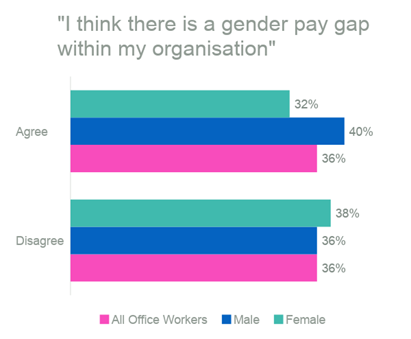Talent Trends 2025
Gain a competitive hiring advantage by learning what top talent wants.


Michael Page’s Talent Trends survey of 5,000 UK office workers has uncovered that male office workers are more likely than their female colleagues to believe that a gender pay gap exists at their organisation.
To be clear, a gender pay gap does exist across the UK. Government figures show that there was an average 15% gap in median gross hourly earnings between men and women in 2021, down from 27.5% in 1997. However, our research showed that employees are skeptical about a gender-based pay divide within their companies.
The research, conducted as part of our Talent Trends series, revealed that one-third (36%) of UK office workers believe their employer has a gender pay gap, while the same proportion believes the gender pay gap does not exist.
Interestingly, more men (40%) than women (32%) agree that there is a gender pay gap at their organisation, and men are also slightly less likely than women to disagree that there is a gender pay gap at their organisation (36% vs. 38%).

As with any research, the top-level figures tell a different story to the more granular results. With that in mind, we have segmented the survey results across multiple categories — including age, gender, location, industry, and seniority — to uncover more meaningful insights. Here are three key learnings we discovered
Of course, for junior employees, this is a purely hypothetical question — a case of whether or not they think their organisation has a gender pay gap. They might know how much their closest colleagues are being paid, but are unlikely to have any meaningful insight across the organisation as a whole.
For leadership-level employees, the question is less likely to be a matter of guesswork, because they (should) possess at least some insight into how much people beneath them are being paid.
So, it is worth noting that a stark difference can be seen when the results are segmented by seniority. Two-thirds (65%) of employees at or above-board level say their organisation has a gender pay gap, dropping to just 29% among those below board level.
Similarly, among employees earning up to £30,000 a year, just one-quarter (25%) believe in a gender pay gap at their organisation. This climbs to one-third (32%) of those earning £30,001 – £60,000 a year, and three-fifths (62%) of employees with salaries of £60,001+.
On average, half (52%) of all UK office workers believe their pay is in line with standards seen across their industry.
Despite 40% of men believing their organisation has a gender pay gap, 61% of male employees feel their pay matches industry standards, dropping to just 42% among women.
Unsurprisingly, there are wide variances in results across industries. For instance, 70% of office workers in the construction sector believe their pay is broadly aligned with the rest of the industry, compared to just 46% in the wholesale, retail, and franchising space.
In total, 33% of office workers in our survey believe they are underpaid by the standards of their industry. We wanted to understand the level to which these employees feel they are underpaid.
Asked how much greater their salary should be per annum to reach industry standards, the most popular response — given by 34% employees who felt they were underpaid — was between £1,001 and £3,000. In all, 66% felt that £1,001 – £5,000 is missing from their yearly pay, while roughly one in eight (12%) said their pay would need to rise by more than £7,500 to fall in line with industry standards.
Women are most likely to say they are underpaid by £1,001 – £3,000 a year (cited by 39% of female respondents who agree their pay is beneath industry standards), while the most common response among men was £3,001 – £5,000 (33%).
Unsurprisingly, lower-paid employees are more likely to cite lower levels of underpayment than their higher-paid peers.
Among those earning up to £30,000 who say they are underpaid, 44% say their salary should be increased by £1,001 – £3,000 a year. Meanwhile, 37% of employees earning £30,000 – £60,000 a year say their salary should rise by £3,001 – £5,000, with 18% of employees in this category citing an upturn of £5,001 - £7,500 to bring their pay in line with industry standards.
We sat down with our in-house inclusivity expert, DE&I Senior Manager, Bolu Faseun, who shared her invaluable insights into what companies can be doing to bridge the gender pay gap and create equitable and inclusive company cultures.
“In my experience, caring responsibilities and part-time roles are shared unequally. Unfortunately, the pay gap worsens when women take maternity leave and usually never recovers. The pay gap among mothers gets worse consistently for 12 years after the first child is born, by which point women receive 33% less pay per hour than men, according to the Institute for Fiscal Studies. Upon return, women are also more likely to take on part-time roles.
“What’s the solution here? The Nordics have used initiatives such as increased paternity leave to tackle the expectation of gender roles actively. Increased paternity leave allowance normalises fathers also taking that time off. If society and work by extension treated parental leave as a normal part of life, essential for the flourishing of the whole family, and not as an inconvenience to staffing which applies only to women, more staff coming back after parental leave would be re-onboarded in a fair manner, without a negative impact in terms of pay.
“Support systems allow primary caregivers to feel comfortable and backed while balancing work and family life. This could mean establishing a company run creche, emergency childcare cover, and flexible hybrid working arrangements where needed.”
Retaining top talent starts with hiring the right candidates, so be sure to check out our guide on persuading star candidates to join your business, which runs through all the major steps to becoming an employer of choice.
Ready to hire? Get in touch with Michael Page today.
Gain a competitive hiring advantage by learning what top talent wants.